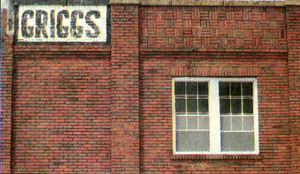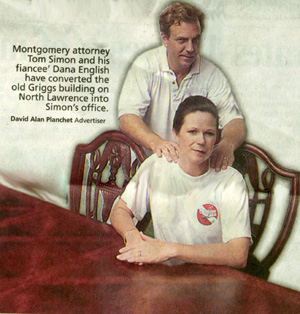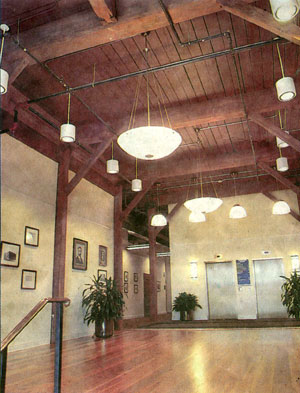DOWNTOWN ENTHUSIASTS
INDIVIDUALS AND PRIVATE ENTERPRISES ARE LAYING
THE GROUND WORK FOR AN URBAN RENAISSANCE

 Tom Simon has had his eye on the old
Griggs grocery store warehouse in downtown Montgomery for years.
Tom Simon has had his eye on the old
Griggs grocery store warehouse in downtown Montgomery for years.
Vacant and boarded up for more than a decade, the
sturdy two-story brick building at Jefferson and Lawrence streets held a
possibility to Simon that few others saw, including the bankers he asked
to help fund a renovation.
"Originally, they thought I was crazy," said Simon, a
Montgomery attorney. That was early this year. Last week, Simon moved his
law office into the old warehouse.
Renovating the 6,000 square-foot space has taken most of
the summer and cost Simon about $200,000, including the $75,000 he paid
for the property and he's only done the first floor. But you won't hear
him complaining. "I'm in the middle of downtown on a two-way street with a
parking lot," he said. "This place is a rare find."
 City
leaders and proponents of redeveloping the downtown portion of the
riverfront hope more private investors will follow Simon's lead.
City
leaders and proponents of redeveloping the downtown portion of the
riverfront hope more private investors will follow Simon's lead.
The city has spent almost $65 million in local, state and
federal money over the past decade to get the ball rolling. The hope is
that private investment, which tallies up at almost $35 million over the
same period, according to a new estimate by the Montgomery Chamber of
Commerce, soon will surpass the public investment in the area.
"I'm pleased at this point and time with the pace" of
public and private investment at the riverfront, said Mayor Bobby Bright,
who has made downtown revitalization a focal point of his administration.
"But I wish it would move more quickly so we wouldn't have to deal with so
many nay-sayers along the way"
Critics have taken shots at Bright for spending so much
public money on downtown projects, such as a $26 million minor-league
baseball stadium for the Montgomery Biscuits, which will be funded mostly
by Montgomery lodging tax revenues they believe could be better spent
elsewhere.
If the city had not taken the lead downtown, private
developers would have stayed on the sidelines for longer than they have,
said Gail Alsobrook, executive director of the nonprofit Montgomery
Riverfront Development Foundation. "I think the citizens needed to see
that the city was committed."
 The Montgomery Riverfront and Downtown Master Plan
of May 2001 identified three types of "catalyst projects" that would spur
investment downtown: basic infrastructure improvements, such as parking
garages and street enhancements; cultural or nonprofit projects such as a
museum or IMAX theater; and "private real estate projects that need some
targeted public investment to become feasible."
The Montgomery Riverfront and Downtown Master Plan
of May 2001 identified three types of "catalyst projects" that would spur
investment downtown: basic infrastructure improvements, such as parking
garages and street enhancements; cultural or nonprofit projects such as a
museum or IMAX theater; and "private real estate projects that need some
targeted public investment to become feasible."
The city has in recent years cobbled together millions
from local, state and federal sources for infrastructure improvements,
including the $15 million parking facility at Molton and Water streets
beginning construction this fall and the $280,000 reroute of Bell and
Tallapoosa streets. The city has also found money for cultural and
entertainment projects downtown such as the $10 million River-walk and the
$300,000 Riverskate park.
However, the private real estate projects hoped for in the
master plan have been slower to come. There is little sign of a Warehouse
District with restaurants and entertainment options. Few new residents
have moved downtown, nor have retailers. "I like to think we could move
faster," Alsobrook said.
Despite the plodding pace of private development to this
point, Alsobrook is heartened by a new crop of investors downtown she
believes will attract others to the area.
Her foundation has done its part, buying the former Webber
Department store building at Perry and Monroe streets for $350,000 in
February. The group now is working to stabilize the aging structure, but
has no immediate plans for a specific project there, she said.
A few other private projects are also under way at the
Riverfront.
Sam Adams, owner of Adams Life Insurance in
Montgomery, has purchased the old Ice House building and former Todd's
Gun Shop site, both at Jefferson and Court streets. Montgomery
construction company owner Ken Upchurch said his firm is putting a
retail shop or office on the ground floor of the gun shop and six loft
apartments on the two upper floors. A city ordinance, passed last fall,
allows downtown buildings to contain residential and commercial uses and
is expected to entice more loft developers. A separate company is
working on the Ice House building, and no details were immediately
available about that project.
Across the street at the Montgomery Brewing Co., owners
are getting closer to finishing a second floor, which would add a
private dining room, cigar-smoking area and pool tables. "We're down to
the big stuff now," manager Chris Ellis said. An elevator, staircase and
AC unit would complete the second level, he said, making no predictions
about when that may occur.
Elsewhere, a four-story warehouse at 101 Tallapoosa
St. is being eyed for ground-level retail and high-end office space.
"I'm confident we'll be under development sooner rather than later,"
said Daniel Hughes, chief executive of Montgomery investment group
Summit America. Montgomery law firm Rushton, Stakely, Johnston and
Garrett PA owns the building and is considering a partnership with
Summit to renovate it, Hughes said. "
The former Schloss & Kahn warehouse at 121 Coosa St.
also is being considered for redevelopment. "I think when we get
finished renovating it, it will have between $1.2 million and $1.5
million in it," said Randy Roark, partner in Montgomery-based shopping
center development company Helms-Roark.
Roark's firm bought the 17,000 square-foot building in
February and is planning retail stores for the ground floor and offices on
the second. He said construction could begin within 90 to 120 days.
"I deeply believe that downtown and the Riverfront are
tremendous economic development opportunities," said Hughes, whose firm
spent $8 million renovating the Winter-Loeb building on Tallapoosa Street.
The office building opened with its first tenants in July and this month
signed another lease, bringing total occupancy to 100 percent.
Based on current population growth trends in the
Montgomery area, the 2001 Master Plan predicted the downtown and
riverfront could capture 25 percent or about 300,000 to 350,000 square
feet of new office space over the next 15 years.
Hughes said the fact that his building leased so quickly
illustrates the demand is already there. "If you build (an office
building) and you market it, then you have a reasonable chance of getting
it leased."
Now, if other developers would just take the leap, said
Bright, then downtown would be well on its way to recovery. "I'm pleased
with what's going on down there," he said. "But we've got a long way to
go."
Brett Clanton can be reached at 956-0258,
by fax at 261-1521 or by email at bclanton@montgomeryadvertiser.com.
![]()